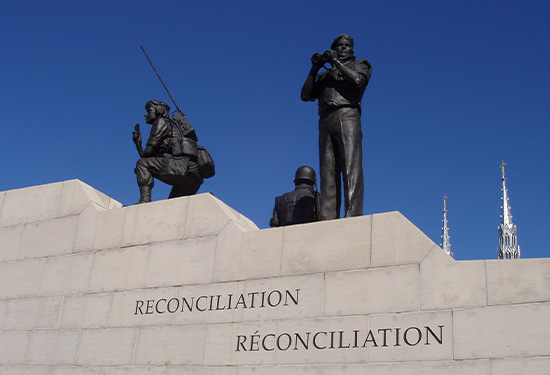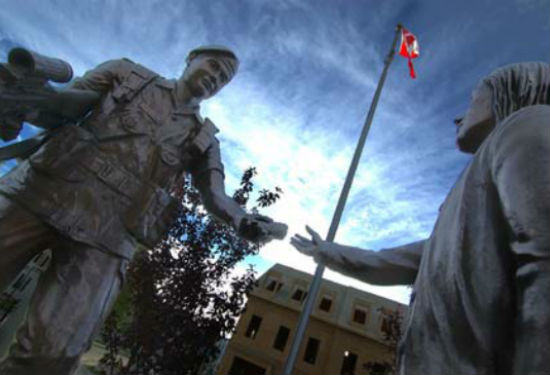Order of events
30 June 1960
The Congo becomes an independent country.
1960-1964
Canadian peacekeepers first serve in the Congo.
1961
United Nations Secretary-General Dag Hammarskjold dies in a plane crash while in Africa trying to negotiate a peaceful resolution to the hostilities.
1971-1997
The Congo is renamed Zaire.
1996
More than 350 Canadians join a short-lived multinational force to provide humanitarian aid and help refugees return home.
1997
A violent coup occurs in the Congo.
1999-present
Canadian Armed Forces members deploy to the Congo as part of Operation Crocodile to help stabilize the region.
Classroom materials
The Democratic Republic of the Congo has a long history of instability and violence. Since 1960, more than 2,500 Canadians have taken part in several peace support operations there. Their work has tried to restore security and freedom to the people of the Congo, as part of international efforts to help stabilize and rebuild the country.
The Congo
The Congo is a large country in central Africa (almost as large as Ontario and Quebec combined). It is home to more than 95,000,000 people. When it comes to natural resources, the Congo is one of the richest countries in the world, but its people have often had to endure great poverty. The ecologically diverse Congo straddles the equator and is home to the second-largest rainforest in the world.
A stormy transition
The Congo—formerly known as the Congo Free State, Belgian Congo and Zaire—has a turbulent history. The country suffered greatly during its 90-year colonial period and on 30 June 1960, it finally gained its independence from Belgium.
The transition from colony to nationhood was very difficult. Belgian officials had not prepared for the transfer of power to the local people. There were many stresses on society that threw the country into a state of chaos when the Belgians departed. The Congolese endured political in-fighting, inter-tribal tensions, famine, an army mutiny, international interference and widespread violence.
United Nations operation in the Congo
Days after the Congo declared independence, Belgium sent troops back to the country to try to restore order and protect Belgian citizens who were still living there. However, they didn’t have permission to do so from the newly formed country.
In mid-July 1960, the Congo government asked the United Nations to help deal with this “external aggression.” Concerned with the volatile political situation, social upheaval, and starvation, the United Nations called on Belgium to leave the Congo. The United Nations quickly sent international peacekeepers to ensure the Belgian troops left, and to help restore order and stability.

Lieutenant Colonel Paul Augustus Mayer reviews a map with fellow Canadian soldiers. They helped plan and carry out a helicopter rescue to evacuate missionaries in Kwilu province in the Congo. Mayer was awarded the George Medal for this action. January 1964. Photo: Department of National Defence
Only a large contingent of peacekeepers could possibly make a difference in a huge country in such turmoil. More than 20,000 United Nations personnel—including more than 300 Canadians—would soon serve in the Congo. Thousands of civilian foreign aid workers also travelled there to provide food and assistance.
Francophone Canadians sought
Due to the Congo’s background as a Belgian colony, francophone peacekeepers were in high demand. The United Nations asked Canada to send French-speaking signallers to participate in the large mission. French-Canadian officers also held key positions in the United Nations command.

On their second patrol out of Léopoldville in the Congo, a French-speaking Canadian Provost Corps member of the UN Military Police Company chats with a trooper from Ireland. 1963. Photo: Department of National Defence UNC63-5-4
At the beginning of the mission, Canadian Lieutenant-Colonel Jean Berthiaume was chief of staff of the United Nations forces in the Congo. He was later named an Officer of the Order of the British Empire for his impressive efforts. He was the first Canadian to receive this honour since the Second World War. Lieutenant-Colonel Berthiaume was known for his organizational skills, bravery, initiative, linguistic ability and special talent for negotiating.
Change in the United Nations peacekeeping role
A few years before arriving in the Congo, United Nations troops launched their first large-scale peacekeeping effort in response to the Suez Crisis in Egypt. But in the Congo, UN troops soon found themselves exposed to a new type of peace mission. For the first time, they were authorized to use force, other than strictly in self-defence, to fulfill their mandate.
The mission’s military focus was to preserve the territorial integrity of the country. Peacekeepers prevented break-away portions of the Congo from seceding and helped push out the foreign mercenaries who contributed to political instability.
In the end, the United Nations forces were not enough to stop the upheaval. The initial United Nations international peace effort ended when they left the country in 1964.
Upheaval in the 1990s
The Congo has remained a troubled country. Renamed Zaire between 1971 and 1997, it suffered under a dictatorship for decades. Major conflict erupted again in the mid-1990s. Refugees from the neighbouring countries of Rwanda and Burundi streamed into the eastern parts of the Congo. Canada tried to address the growing crisis in 1996. For a few weeks, more than 350 Canadians joined a short-lived multinational force to provide humanitarian aid and help refugees return home.
A violent coup occurred in the Congo in 1997. Ethnic strife and civil war soon engulfed the country. Some reports suggest that up to 3.8 million people died in the ensuing violence.

Captain Paul Anderson (right) and flight engineer Sergeant Tony Kester wait at the controls of their CC-130 Hercules. This Canadian Armed Forces flight transported French troops into Bunia, Democratic Republic of the Congo. 2003. Photo: Combat Camera
Operation Crocodile
In 1999, the United Nations intervened once again with a military mission that continues today. At times, the mission consisted of almost 18,000 personnel from around the world. Canadian Armed Forces members deployed as part of Operation Crocodile, and have been a part of the ongoing effort to help stabilize the region. They have made important contributions such as flying in supplies and personnel, providing mission staff and supporting humanitarian aid efforts.

Corporal Stephanie Côté, a Canadian Armed Forces Military Police member, speaks with local people in the Democratic Republic of the Congo. 19 November 2021. Photo: Department of National Defence ISB0016D0021
Canadians recognized
A number of courageous Canadian service members received high honours for their actions in the Congo.
Brigadier-General Jacques Dextraze was chief of staff of the UN forces therefrom 1963 to 1964. He led a series of missions to rescue groups of non-combatants from combat zones. For his brave service, Dextraze was named a Commander of the Order of the British Empire, with oak leaf.
Lieutenant J.F.T.A. Liston of the Royal 22e Régiment rescued a wounded Congolese from a minefield. He was made a Member of the Order of the British Empire.
Lieutenant-Colonel Paul Mayer and Sergeant J. A. L. Lessard each received the George Medal for rescuing priests and nuns from dangerous situations. At one point, Sergeant Lessard single-handedly held off 15 armed enemy soldiers.
Dangerous service
Military missions in the Congo have been particularly challenging and dangerous. Two Canadian service members paid the ultimate price to help the people in the strife-torn country. Since these missions began, more than 650 UN peacekeepers from around the world have died there.

Corporal John Deneumoustier shows a group of interested Indonesians the Sterling sub machine gun with which most of the Canadian troops are equipped. 1961. Photo: Department of National Defence
- Date modified:




















